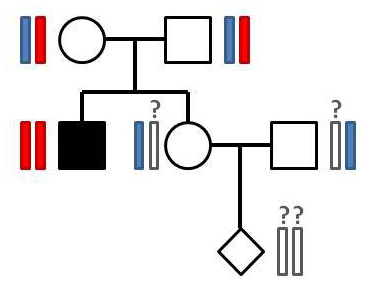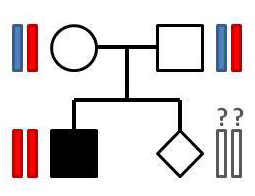Risk calculation of autosomal recessive inheritance
In recessive disorders the symptoms are only seen in a person if both alleles of the gene carries mutations; or, in other words, if the person carries no normal, functional allele of the gene. This means that heterozygous individuals are healthy, but if both parents are heterozygous carriers of the disease there is a risk that their offspring receive mutated alleles from both and thus become homozygous and affected. When assessing the risk that a child or fetus will be affected by an autosomal recessive genetic disease we therefore have to start by establishing calculating the risk that each of the parents are healthy carriers. In order to do so we look at the pedigree: do we know of any ancestors who were affected with the disease? If not, we need to know the general carrier frequency in the population, but if any ancestors were affected the risk calculation will start with them. If the parent of a person is affected the carrier risk of all offspring is 100%, as the homozygous parent in all cases will pass on a mutated allele of the gene. This of course provided that the other parent carries two normal alleles.

Figure 1. A pedigree showing autosomal recessive inheritance.
If a sibling is affected, the calculation of the carrier risk in all unaffected sibling goes as follows: if one sibling is affected we know that both parents most likely are heterozygous carriers (if they are healthy), meaning that they both may pass on the mutation. The combinations of alleles that can be found in their offspring are heterozygous with a disease allele from the mother, heterozygous with a disease allele from the father, homozygous with two normal alleles or homozygous with two mutated alleles. However, if the sibling in question is healthy we can rule out the fourth combination, homozygous with two mutated alleles, as this would cause the individual to be affected (which he/she is not). This leaves three possible combinations of alleles in question for this person, and in two of these the individual carries one mutated allele, i.e. is a heterozygous carrier. In other words, if a sibling is affected the carrier risk of the healthy siblings is 2/3. Once you have assessed the carrier risk of a person you calculate the carrier risk of that persons offspring by dividing the risk by 2, reflecting the fact that each time a potential heterozygous person passes on one of that persons alleles to a child there is a 50% chance that it is the normal allele that is passed on. As a rule of thumb, when we know the disease status we assess the risk if healthy individuals are heterozygous carriers; when we don’t know whether the child or fetus is affected, we calculate the risk that this individual is homozygous and affected. Once you have assessed the carrier risk of the parents of the child or fetus, you calculate the disease risk by multiplying the risk that the mother passed on a disease-causing allele with the risk that the father did. If both parents are heterozygous this risk is ½ * ½ = ¼.

Figure 2. A pedigree showing autosomal recessive inheritance risk for siblings.